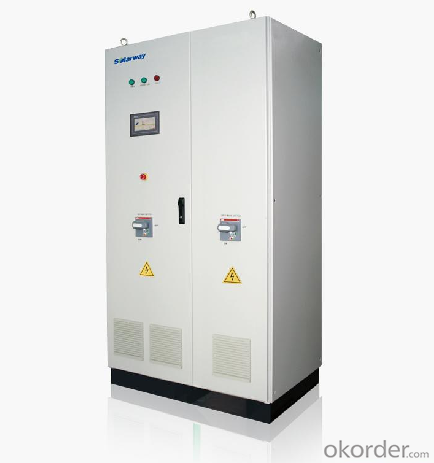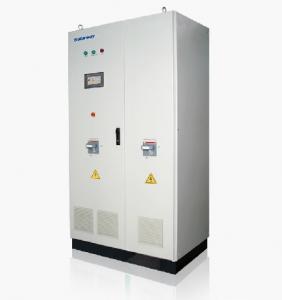PV On-grid Inverter GSG-500KL from CNBM China
OKorder Service Pledge
OKorder Financial Service
You Might Also Like
Description:
CNBMSOLAR is a world-leading and Vertical integrated manufacturer of high-performance with Silicon,
Wafer, Cells, Modules, which convert sunlight into electricity for residential, commercial, and utility-scale
power generation.
The capacity of CNBMSOLAR is reach to 1GW, and make sure each year our shipment capacity is more
Than 700-800MWs, at the same time, we have set up the largest solar power station with our partner
in Ukraine.
CNBM is a Quality + Service oriented company with“Excellence at Each Step” approach, composed of
the finest components from TUV and IEC-certified partners around the world, CNBM modules consistently
undergo a variety of trials at the company’s Test & Development Centre, ensuring peak performance
capabilities. The company is committed to develop and provide the world with clean and renewable energy
to ease the energy shortages as well as human kind’s impact on the environment
Technicalparameters
Electrical plant
Items | Parameters | |
DC input | Maximum DC input power (KWp) | 550kW |
Maximum PV open-circuit voltage(VDC) | 1000VDC | |
Maximum PV array input current(A) | 1250A | |
DC input voltage range (VDC) | 0~1000VDC | |
MPPT voltage range (VDC) | 500~850VDC | |
AC output | Rated output power (KW) | 500kW |
Operating voltage range (Vac) | 315Vac | |
Operating frequency(Hz) | 47.5~51.5Hz | |
Maximum efficiency(%) | 98.6% | |
Power factor | ≥0.99 | |
THD(%) | <3% | |
Self-consumption at night(W) | <80W | |
Noise emission | ≤65dB(1m) | |
Protection function | Protection rating | IP20(indoor) |
Over/Under voltage protection | Yes | |
Over/under frequency protection | Yes | |
Anti-islanding protection | Yes | |
Over current protection | Yes | |
Polar reversed wiring protection | Yes | |
Overload protection | Yes | |
Usage environment | Usage temperature range | -20℃~+55℃ |
Storage temperature range | -40℃~+65℃ | |
Usage relative humidity | 0~95%RH | |
Altitude | 3000m |
Mechanical plant
Items | parameters |
Dimension (W/H/D) | 950*2000*2140mm |
Weight | 1.423t |
Human-machine interface and communication
Items | Parameters |
Display | LCD-Touch |
Standard communication | RS485 |
Optional communication | GPRS, Ethernet |

FAQ:Could you pls introduce more about CNBM?
CNBM Group is short for China National Building Materials Group Corporation, which is established in 1984 with approval from the State Council
CNBM Group is the largest comprehensive building materials industry group in China
The Group has a total asset of over RMB 360 billion, more than 180,000 employees and 17 subsidiaries
- Q:Can a solar inverter be used in a multi-string configuration?
- Yes, a solar inverter can be used in a multi-string configuration. In fact, many modern solar inverters are designed to handle multiple strings of solar panels. This configuration allows for more flexibility in system design and improves overall performance and efficiency of the solar power system.
- Q:Can a solar inverter be used with different types of solar cell technologies?
- Yes, a solar inverter can be used with different types of solar cell technologies. Solar inverters are designed to convert the DC electricity generated by solar panels, regardless of the type of solar cell technology, into AC electricity that can be used to power homes and businesses. Therefore, whether it is monocrystalline, polycrystalline, thin-film, or any other solar cell technology, a solar inverter can efficiently convert the generated electricity into usable form.
- Q:Can a solar inverter be used with different types of solar PV systems (roof-mounted, ground-mounted, etc.)?
- Different types of solar PV systems, such as roof-mounted, ground-mounted, and other variations, can utilize a solar inverter. The primary function of a solar inverter is to convert the direct current (DC) electricity produced by solar panels into alternating current (AC) electricity. This converted electricity can be used to power appliances and can also be fed into the electrical grid. The conversion process remains consistent regardless of the type of PV system being used. However, it's crucial to consider that the solar inverter's requirements and specifications may differ depending on the type of PV system. Different PV systems may have varying voltage and power outputs, which may necessitate specific inverter models capable of handling these requirements. For instance, ground-mounted solar systems may have larger arrays and higher power outputs than roof-mounted systems, requiring a different type of inverter. Hence, while a solar inverter can generally be used with various types of solar PV systems, it is essential to select an inverter that is compatible with the specific system's voltage, power output, and other technical specifications. It is always advisable to consult with a professional solar installer or technician to ensure the appropriate selection and installation of the solar inverter for your particular PV system.
- Q:How is a solar inverter different from a regular inverter?
- A solar inverter is specifically designed to convert the DC (direct current) electricity generated by solar panels into AC (alternating current) electricity suitable for use in homes and businesses. On the other hand, a regular inverter is mainly used to convert DC electricity from batteries or other sources into AC electricity. Therefore, while both inverters convert electricity from one form to another, a solar inverter is tailored for the unique requirements of solar power systems.
- Q:Can a solar inverter be used with a solar-powered healthcare system?
- Yes, a solar inverter can be used with a solar-powered healthcare system. A solar inverter is an essential component of a solar power system as it converts the direct current (DC) produced by solar panels into alternating current (AC) that can be used to power various healthcare devices and equipment. This allows for the efficient and reliable operation of a solar-powered healthcare system, ensuring uninterrupted access to essential medical services even in remote or off-grid locations.
- Q:How does a solar inverter handle voltage dips and swells?
- A solar inverter is designed to handle voltage dips and swells by constantly monitoring the grid voltage. When a dip or swell occurs, the inverter's control system adjusts the output voltage accordingly to maintain a stable output. This is done through the use of power electronics and control algorithms that regulate the voltage and frequency of the inverter's output.
- Q:How does a solar inverter protect against lightning strikes?
- A solar inverter typically has built-in protective measures, such as surge protection devices and grounding systems, that help safeguard against lightning strikes. These protective measures divert the high voltage surge caused by lightning away from the inverter, ensuring its safety and preventing damage to the solar power system.
- Q:What are the typical efficiency ranges for different types of solar inverters?
- The typical efficiency ranges for different types of solar inverters vary depending on the specific technology and design. However, in general, string inverters have an efficiency range of around 95% to 98%, while microinverters tend to have an efficiency range of about 96% to 99%. On the other hand, central inverters have a wider efficiency range, typically ranging from 95% to 99%. It's important to note that these efficiency ranges can also be influenced by factors such as temperature, load, and design variations among manufacturers.
- Q:Can a solar inverter be used in a net metering system?
- Yes, a solar inverter can be used in a net metering system. A solar inverter is an essential component of a net metering system as it converts the direct current (DC) produced by the solar panels into alternating current (AC) that can be used to power homes or businesses. It also allows for any excess electricity generated to be fed back into the grid, earning credits or reducing the electricity bill through the net metering arrangement.
- Q:What is the role of a solar inverter in reactive power control?
- The role of a solar inverter in reactive power control is to regulate and manage the flow of reactive power in a solar power system. It helps to maintain the power factor within an acceptable range, ensuring efficient and stable operation of the system. By adjusting the voltage and reactive power outputs, the solar inverter can compensate for any reactive power imbalances and maintain a balanced grid voltage. This helps to prevent power quality issues and ensures optimal performance and integration of solar energy into the grid.
1. Manufacturer Overview |
|
|---|---|
| Location | |
| Year Established | |
| Annual Output Value | |
| Main Markets | |
| Company Certifications | |
2. Manufacturer Certificates |
|
|---|---|
| a) Certification Name | |
| Range | |
| Reference | |
| Validity Period | |
3. Manufacturer Capability |
|
|---|---|
| a)Trade Capacity | |
| Nearest Port | |
| Export Percentage | |
| No.of Employees in Trade Department | |
| Language Spoken: | |
| b)Factory Information | |
| Factory Size: | |
| No. of Production Lines | |
| Contract Manufacturing | |
| Product Price Range | |
Send your message to us
PV On-grid Inverter GSG-500KL from CNBM China
OKorder Service Pledge
OKorder Financial Service
Similar products
New products
Hot products
Hot Searches
Related keywords





























